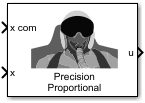Precision Pilot Model
Represent precision pilot model
Libraries:
Aerospace Blockset /
Pilot Models
Description
The Precision Pilot Model block represents the pilot model described in Mathematical Models of Human Pilot Behavior [1]. This pilot model is a single input, single output (SISO) model that represents some aspects of human behavior when controlling aircraft. When modeling human pilot models, use this block for more accuracy than that provided by the Tustin Pilot Model and Crossover Pilot Model blocks.
This block has non-linear behavior. If you want to linearize the block (for example, with
linearize (Simulink Control Design) or one of the linmod functions), you might need to change the Pade approximation
order. The Precision Pilot Model block implementation incorporates the
Transport Delay block with the
Pade order (for linearization) parameter set to
2 by default. To change this value, use the set_param function, for example:
set_param(gcb,'pade','3')
Note
The linmod function provides only basic linearization
capabilities. For full linearization functionality, use Simulink®
Control Design™ software. For more information, see Choose Linearization Tools (Simulink Control Design).
This block is an extension of the Crossover Pilot Model block. It implements the equation described in Algorithms.
Ports
Input
Output
Parameters
Algorithms
When calculating the model, this block also takes into account the neuromuscular dynamics of the pilot. This block implements the following equation:
where:
| Variable | Description |
|---|---|
| K p | Pilot gain. |
| τ | Pilot delay time. |
| T L | Time lead constant for the equalizer term. |
| T I | Time lag constant. |
| T N1 | Time constant for the neuromuscular system. |
| ω N | Undamped frequency for the neuromuscular system. |
| ζ N | Damping ratio for the neuromuscular system. |
A sample value for the natural frequency and the damping ratio of a human is 20 rad/s and 0.7, respectively. The term containing the lead-lag term is the equalizer form. This form changes depending on the characteristics of the controlled system. A consistent behavior of the model can occur at different frequency ranges other than the crossover frequency.
References
[1] McRuer, D. T., Krendel, E., Mathematical Models of Human Pilot Behavior. Advisory Group on Aerospace Research and Development AGARDograph 188, Jan. 1974.
[2] McRuer, D. T., Graham, D., Krendel, E., and Reisener, W., Human Pilot Dynamics in Compensatory Systems. Air Force Flight Dynamics Lab. AFFDL-65-15. 1965.
Extended Capabilities
Version History
Introduced in R2012b
